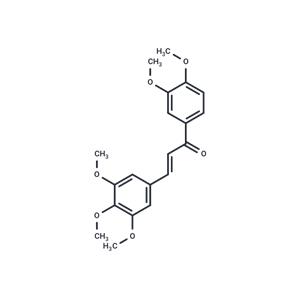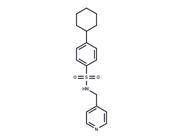| Name | MD2-IN-1 |
| Description | MD2-IN-1 is a Myeloid differentiation protein 2 (MD2) inhibitor with a KD of 189 μM for the recombinant human MD2 (rhMD2). |
| Cell Research | Mouse RAW264.7 macrophages are starved for 3?h before experimentation. Cells are incubated with or without FITC-LPS (50?μg/mL) in the presence or absence of MD2-IN-1 (0.1, 1 and 10?μM) for 30?min. After incubation, macrophages are fixed with paraformaldehyde for 10?min at 4°C and washed with PBS before being analyzed by flow cytometry. |
| Animal Research | Male Sprague Dawley (SD) rats are randomly divided into three groups,designated "control" (5 rats,only receive the vehicle of 0.9% saline),"LPS" (7 rats,receive 5?mg/kg LPS alone) and "MD2-IN-1 (20)?+?LPS" (6 rats,receive both MD2-IN-1 and 5?mg/kg LPS).Prior to LPS-induced Acute lung injury (ALI),the MD2-IN-1+LPS group rats are treated intragastrically with MD2-IN-1 at a dosage of 20?mg/kg/day continuously for one week.Under ether anesthesia,all the rats are exposed their trachea and challenged with intratracheal instillation of 50?μL of LPS,while the control group challenged with intratracheal instillation of 50?μL of 0.9% saline.Rats are then euthanized with ketamine after 6?h of LPS induction. |
| In vitro | Pre-treatment with different doses of MD2-IN-1 dose-dependently reduces FITC-LPS binding to MD2 in cell surface membranes, with a 65% inhibition at 10?μM in terms of mean fluorescence intensity. Pretreatment with MD2-IN-1 also dose-dependently blocks LPS-induced MAPK phosphorylation in the MPMs. Compared to the vehicle, LPS alone largely increases the amount of TLR4/MD2 complex, while pretreatment with MD2-IN-1 inhibits the increase of TLR4/MD2 complex to the vehicle level. SPR analysis shows that MD2-IN-1 exhibits recognizable binding to rhMD2 protein in a dose-dependent manner, with a KD value of 189?μM, while the KD value of xanthohumol binding to MD2 is 460?μM. |
| In vivo | In the LPS-treated group, the lung wet/dry weight ratio significantly exceeds that of controls, indicating LPS-induced pulmonary edema, which MD2-IN-1 treatment effectively mitigates. Additionally, MD2-IN-1 markedly lowers the elevated protein levels in BALF caused by LPS. LPS administration results in noticeable lung histopathological alterations, such as inflammatory infiltration, hemorrhage, interstitial edema, alveolar wall thickening, and lung tissue destruction, all of which are significantly improved with MD2-IN-1 treatment. |
| Storage | Powder: -20°C for 3 years | In solvent: -80°C for 1 year | Shipping with blue ice. |
| Solubility Information | DMSO : 55 mg/mL (153.46 mM)
|
| Keywords | inhibit | MD2-IN-1 | Inhibitor | MD2IN1 | Toll-like Receptor (TLR) | MD-2-IN-1 | MD2 IN 1 |
| Inhibitors Related | Polyinosinic-polycytidylic acid sodium | CU-CPD107 | Imiquimod hydrochloride | Hydroxychloroquine | Chloroquine phosphate | Hydroxychloroquine sulfate | Chloranil | Chloroquine | CU-115 | Imiquimod | TLR3-IN-1 | Resiquimod |
| Related Compound Libraries | Nonsteroidal Anti-Inflammatory Compound Library | Bioactive Compound Library | Membrane Protein-targeted Compound Library | HIF-1 Signaling Pathway Compound Library | Pyroptosis Compound Library | Inhibitor Library | NO PAINS Compound Library | Immuno-Oncology Compound Library | Bioactive Compounds Library Max |

 United States
United States



